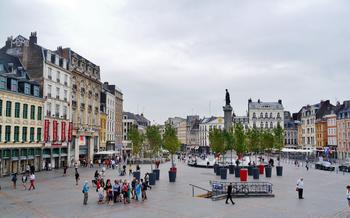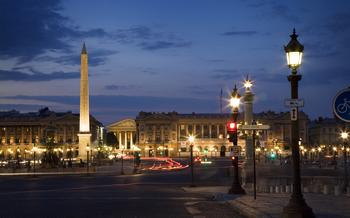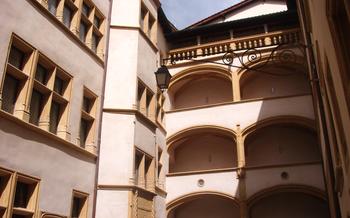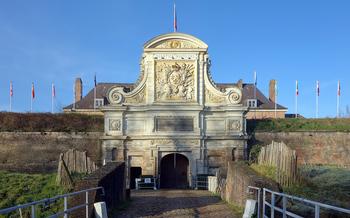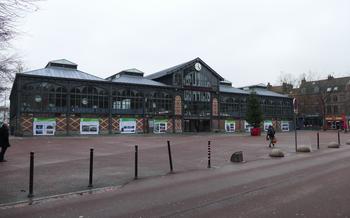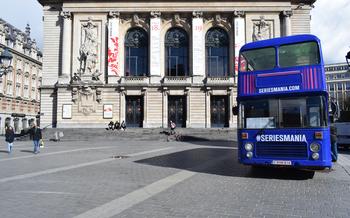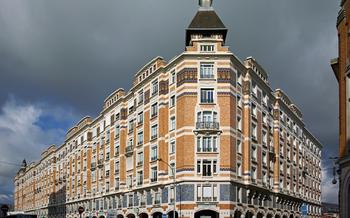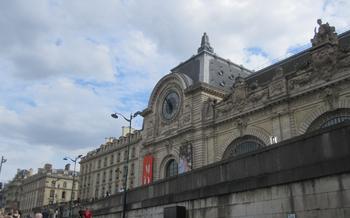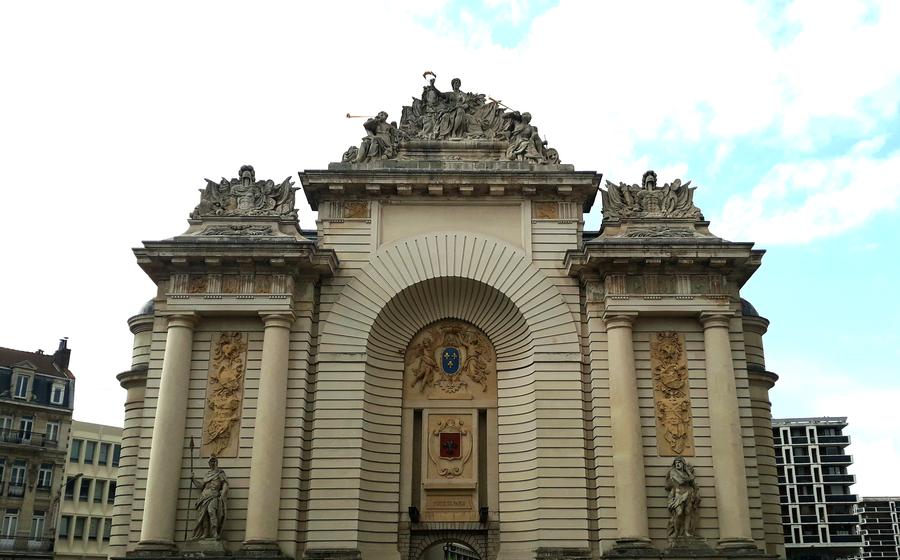
Porte de Paris
- The Porte de Paris: A Monumental Entrance to Lille
- Promenade of the Citadel: A Green Haven by the Porte de Paris
- The Vauban Citadel: A Defensive Masterpiece
- The Porte de Paris Metro Station: A Modern Gateway
- Grand Palais: A Venue for Art and Culture
- The Musée des Canonniers: A Glimpse into Military History
- The Porte de Paris Flea Market: A Treasure Trove for Shoppers
- The Porte de Paris Tram Stop: A Convenient Transportation Option
- The Porte de Paris Bus Stop: A Budget-Friendly Alternative
- The Porte de Paris Parking: A Hassle-Free Option for Drivers
- Nearby Restaurants: A Culinary Adventure Awaits
- Hotels near the Porte de Paris: A Comfortable Stay Assured
- The Porte de Paris at Night: A Different Perspective
The Porte de Paris: A Monumental Entrance to Lille
The Porte de Paris, a remarkable 17th-century triumphal arch, stands as a grand gateway to the city of Lille, northern France. Commissioned by King Louis XIV, this imposing structure was designed by renowned military engineer Sébastien Le Prestre de Vauban. Originally intended as part of Lille's fortifications, the Porte de Paris served as a symbolic entrance to the city and a testament to its military prowess. Over the centuries, it has borne witness to Lille's rich history, from its time as a Spanish possession to its eventual incorporation into France. Today, the Porte de Paris remains an iconic landmark, attracting visitors with its impressive architecture and historical significance.
Architectural Features
The Porte de Paris is a masterpiece of Baroque architecture, showcasing intricate carvings, sculptures, and decorative elements. Its imposing façade features a central arch flanked by two smaller arches, all adorned with elaborate moldings and garlands. Atop the arch, a triangular pediment displays the coat of arms of the city of Lille, while the sides are adorned with statues representing the gods Mars and Minerva. The structure is crowned by a balustrade and four decorative vases, adding to its grandeur and elegance.
Location and Accessibility
The Porte de Paris is strategically located at the eastern entrance to the city center, where it forms part of the city's historic fortifications. It marks the beginning of the Rue de Paris, a vibrant shopping street leading to the heart of Lille. The Porte de Paris is easily accessible by foot, bicycle, or public transportation, making it a convenient starting point for exploring the city.
Promenade of the Citadel: A Green Haven by the Porte de Paris
Just outside the Porte de Paris, visitors can find the Promenade of the Citadel, a peaceful green space with a remarkable history. Created in the 17th century as part of the Vauban Citadel's defense system, the promenade now offers stunning panoramic views of the city, making it a popular spot for locals and tourists alike.
Stroll along the promenade's tree-lined paths, and you'll be rewarded with breathtaking vistas of Lille's urban landscape. The city's iconic landmarks, such as the Palais des Beaux-Arts and the Tour de Lille, can be seen from various vantage points, creating picture-perfect moments.
In addition to its scenic beauty, the Promenade of the Citadel is also a haven for recreational activities. Jogging paths, playgrounds, and a skating rink provide ample opportunities for visitors to stay active and enjoy the outdoors. The serene atmosphere of the park makes it an ideal place for picnics, leisurely walks, or simply relaxing and soaking up the sun.
The promenade's historical significance further enhances its charm. As part of the Vauban Citadel, it played a crucial role in defending the city against attacks. Today, it stands as a testament to Lille's rich past and its commitment to preserving its heritage.
The Vauban Citadel: A Defensive Masterpiece
The Vauban Citadel, a formidable fortress constructed by famed military engineer Sébastien Le Prestre de Vauban in the 17th century, stands as a testament to Lille's rich military history. Its imposing ramparts, intricate bastions, and strategic location made it a key defensive stronghold during numerous sieges.
Architectural Features:
-
Pentagonal Shape: The citadel's unique pentagonal shape, a hallmark of Vauban's designs, provided multiple lines of defense and prevented attackers from gaining a clear line of sight.
-
Star-Shaped Bastions: The citadel's star-shaped bastions, jutting out from the main walls, allowed defenders to flank attackers and provided crossfire coverage.
-
Moats and Drawbridges: Deep moats surrounded the citadel, acting as a formidable obstacle for invading forces. Drawbridges, controlled from within the fortress, provided access across the moats.
-
Casemates and Galleries: The citadel's interior featured a network of underground casemates and galleries, providing shelter for soldiers and enabling them to move undetected beneath the fortress.
Historical Background:
-
Fortified City: Lille's strategic location near the border with the Spanish Netherlands made it a prime target for attack. The construction of the citadel was part of a larger effort to fortify the city and protect it from invasion.
-
Numerous Sieges: The citadel withstood numerous sieges throughout its history, most notably during the Franco-Dutch War in 1667 and the War of the Spanish Succession in 170Its strong defenses proved effective in repelling enemy forces.
-
UNESCO World Heritage Site: In recognition of its exceptional military architecture and historical significance, the Vauban Citadel was designated a UNESCO World Heritage Site in 200
Current Use as a Public Space:
Today, the Vauban Citadel stands as a symbol of Lille's resilience and military heritage. It has been transformed into a vibrant public space, open to visitors for exploration and leisure activities.
-
Park and Gardens: The citadel's vast grounds now feature lush parks and gardens, inviting visitors to stroll, relax, and admire the panoramic views of the city.
-
Cultural Events: The citadel regularly hosts cultural events, exhibitions, and concerts, showcasing the city's rich history and vibrant cultural scene.
-
Guided Tours: Guided tours of the citadel are available, providing visitors with insights into its architectural features, military significance, and stories from its past.
The Porte de Paris Metro Station: A Modern Gateway
The Porte de Paris Metro Station, a modern marvel of architecture and transportation, seamlessly blends convenience with aesthetics. Its sleek design, featuring glass and steel elements, blends harmoniously with the historic surroundings. The station serves as a vital transportation hub, connecting travelers to various parts of the city.
Conveniently located near the Porte de Paris, the metro station offers easy access to numerous attractions. It directly connects to Line 1 of the Lille Metro, providing a quick and efficient way to reach the city center and other popular destinations. The station's strategic placement makes it an ideal starting point for exploring Lille's rich cultural and historical offerings.
From the Porte de Paris Metro Station, visitors can embark on a journey through time and discover the city's vibrant urban fabric. Whether seeking the artistic treasures of the Palais des Beaux-Arts, the grandeur of the Old Town, or the lively atmosphere of the Wazemmes Market, the metro station serves as a gateway to Lille's diverse attractions.
Grand Palais: A Venue for Art and Culture
The Grand Palais, situated near the Porte de Paris, is an iconic landmark that seamlessly blends historical charm with modern functionality. Built in 1913, this architectural masterpiece stands as a testament to the grandeur of Lille's past. Its impressive facade, adorned with intricate carvings and sculptures, hints at the treasures that await within.
As a thriving cultural hub, the Grand Palais hosts a diverse array of exhibitions, concerts, and events throughout the year. Art enthusiasts can immerse themselves in captivating exhibitions showcasing masterpieces from renowned artists, both local and international. The Grand Palais also serves as a platform for performing arts, hosting concerts, theater productions, and dance performances that enthrall audiences with their creativity and energy.
The architectural significance of the Grand Palais extends beyond its ornate exterior. The building's vast interior is a marvel of engineering, featuring a soaring glass roof that floods the space with natural light. This unique design creates a harmonious blend of indoor and outdoor elements, enhancing the visitor experience.
Conveniently located just a short walk from the Porte de Paris metro station, the Grand Palais is easily accessible from anywhere in the city. Its proximity to other cultural attractions, such as the Palais des Beaux-Arts and the Musée d'Histoire Naturelle, makes it an ideal starting point for an art and culture-filled day in Lille.
The Musée des Canonniers: A Glimpse into Military History
The Musée des Canonniers, nestled within the ramparts of the Vauban Citadel, is a treasure trove of artillery and military history. This captivating museum showcases an impressive collection of cannons, mortars, and other weaponry that once defended the city of Lille. Visitors can embark on a journey through time as they explore the exhibits, which provide insights into the evolution of artillery and its significance in warfare.
The Musée des Canonniers offers an interactive and immersive experience, allowing visitors to engage with the exhibits through hands-on displays and multimedia presentations. Interactive touchscreens provide detailed information about the artillery pieces, their historical context, and their use in various conflicts. Visitors can also witness live demonstrations of cannon firing, offering a glimpse into the thunderous power of these weapons.
The museum's collection extends beyond artillery, encompassing a range of military artifacts, uniforms, and documents. These exhibits shed light on the lives of soldiers, the strategies of warfare, and the impact of military conflicts on the region. The Musée des Canonniers serves as a poignant reminder of Lille's rich military heritage and the sacrifices made by its defenders throughout history.
The Porte de Paris Flea Market: A Treasure Trove for Shoppers
The Porte de Paris Flea Market, held every Sunday morning, is a vibrant and bustling affair that attracts bargain hunters and treasure seekers from far and wide. Set up along the Promenade de la Citadelle, the market offers an eclectic mix of goods, from vintage clothing and furniture to antique jewelry and rare books.
Strolling through the rows of stalls, visitors can discover unique items that tell stories of their own. Whether you're looking for a one-of-a-kind piece of art, a retro fashion find, or a vintage record, the Porte de Paris Flea Market has something for everyone.
The market is also a great place to soak up the local atmosphere. Vendors are friendly and knowledgeable, and shoppers can often strike up conversations and learn about the history behind the items they're selling.
To make the most of your visit, arrive early to avoid the crowds and be prepared to haggle with the vendors. Cash is the preferred method of payment, and it's worth bringing a sturdy bag to carry your purchases.
Whether you're a seasoned flea market pro or a first-time visitor, the Porte de Paris Flea Market is a must-visit destination for anyone looking for a unique and authentic shopping experience in Lille.
The Porte de Paris Tram Stop: A Convenient Transportation Option
The Porte de Paris tram stop, situated in the heart of the city, offers a convenient and efficient mode of transportation for both locals and visitors. With its well-connected tram routes, you can easily navigate Lille and explore its various attractions.
Tram Routes and Connections
The Porte de Paris tram stop serves as a hub for several tram lines, providing direct connections to popular destinations across the city. Lines 1 and 2, for instance, offer a direct route to the city center, allowing you to reach the Grand Place, the Old Town, and the Lille Flandres train station within minutes. Additionally, lines R and T connect the Porte de Paris to the surrounding neighborhoods, including Wazemmes, Saint-Sauveur, and Fives, where you can discover hidden gems and local markets.
Accessibility for Tourists
The Porte de Paris tram stop is strategically located within walking distance of many tourist attractions, making it an ideal starting point for your explorations. The Citadel, the Grand Palais, and the Porte de Paris Flea Market are just a few steps away, allowing you to seamlessly transition between these landmarks without the need for additional transportation.
Tips for Using the Tram System
To make the most of the tram system, consider purchasing a rechargeable Pass Pass, which offers unlimited travel on all trams and buses within the Lille metropolitan area. Single tickets are also available for occasional users. Remember to validate your ticket before boarding the tram to avoid fines. For real-time information on tram schedules and routes, download the Ilévia app or visit their website.
The Porte de Paris Bus Stop: A Budget-Friendly Alternative
For those seeking a more economical mode of transportation, the Porte de Paris bus stop offers a convenient and affordable option. Numerous bus lines converge at this central hub, connecting it to various neighborhoods and attractions throughout Lille. The bus fares are generally lower compared to other forms of public transport, making it an ideal choice for budget-conscious travelers. The bus stop is conveniently located near the Porte de Paris metro station, allowing for easy transfers between different transportation networks.
To navigate the bus system effectively, it is advisable to obtain a bus map or utilize smartphone applications that provide real-time bus schedules and routes. These resources can help you plan your journey efficiently and avoid any potential delays. Remember to have the exact fare ready, as most buses do not accept large bills or provide change. The bus drivers are generally friendly and helpful, so feel free to ask for directions or assistance if needed.
By embracing the local bus system, you can immerse yourself in the daily rhythm of Lille and experience the city like a true local. Whether you're exploring the historic center, visiting museums, or simply soaking in the vibrant atmosphere, the Porte de Paris bus stop serves as a gateway to all that Lille has to offer.
The Porte de Paris Parking: A Hassle-Free Option for Drivers
Driving in Lille can be a breeze, especially if you're heading to the Porte de Paris. There are several parking options available in the vicinity, designed to cater to the needs of visitors and locals alike.
One of the most convenient options is the Porte de Paris Parking, located right next to the monument. The parking lot offers secure and ample spaces for both short-term and long-term parking. The rates are reasonable, making it an affordable choice for those looking for a hassle-free parking experience.
The parking lot is strategically positioned, allowing drivers to easily access the Porte de Paris and the surrounding attractions. It's a short walk from the Grand Palais, the Citadel, and the Porte de Paris Metro Station, making it an ideal starting point for exploring the area.
To find the Porte de Paris Parking, simply follow the signs from the main road. The parking lot is well-lit and well-maintained, ensuring a safe and comfortable parking experience. Whether you're visiting the Porte de Paris for a quick stopover or an extended exploration, the parking lot provides a convenient and reliable solution for drivers.
Nearby Restaurants: A Culinary Adventure Awaits
The Porte de Paris area is a haven for food lovers, with a diverse range of restaurants offering culinary experiences that will satisfy every palate. From traditional French cuisine to international flavors, there's something for everyone.
For an authentic French dining experience, try one of the many brasseries or bistros in the area. Brasseries are typically informal and lively, serving classic French dishes such as steak frites, coq au vin, and escargots. Bistros, on the other hand, are often smaller and more intimate, with a focus on seasonal and regional cuisine.
If you're looking for something a little different, there are also several international restaurants to choose from. Italian, Chinese, Japanese, and Indian cuisines are all well-represented, and there are even a few fusion restaurants that offer a unique blend of flavors.
No matter what your taste buds desire, you're sure to find a restaurant to your liking near the Porte de Paris. Here are a few of our recommendations:
- Le Meert: This historic patisserie is a must-visit for anyone with a sweet tooth. Their signature gaufres (waffles) are a local delicacy, and their chocolates and pastries are also top-notch.
- La Chicorée: This charming bistro serves traditional French cuisine with a modern twist. The menu changes seasonally, but you can always expect to find delicious dishes made with fresh, local ingredients.
- Le Transcontinental: This trendy restaurant offers a unique blend of French and Asian flavors. The menu features dishes such as sushi tacos, pad thai with foie gras, and lamb chops with a miso glaze.
Tips for finding the best dining spots:
- Do your research: Before you go, take some time to research the restaurants in the area and read reviews online. This will help you narrow down your choices and find the places that are most likely to suit your taste.
- Ask for recommendations: If you're not sure where to go, ask your hotel concierge or a local resident for recommendations. They'll be able to point you in the direction of some of the best restaurants in the area.
- Be adventurous: Don't be afraid to try something new. The Porte de Paris area is home to a diverse range of restaurants, so there's sure to be something to your liking, even if it's not something you would normally order.
Hotels near the Porte de Paris: A Comfortable Stay Assured
The Porte de Paris is a vibrant district filled with historical landmarks, cultural attractions, and modern conveniences. Naturally, travelers seeking accommodation have a wide range of options to choose from.
For a luxurious stay, the five-star Grand Hôtel de Lille is an excellent choice, offering elegant rooms, a Michelin-starred restaurant, and a rooftop terrace with panoramic city views.
Those seeking a more intimate experience might prefer the quaint Hôtel de la Paix, a charming boutique hotel with cozy rooms and a friendly atmosphere.
Budget travelers can opt for the Ibis Lille Centre Grand Place, which offers clean and comfortable rooms at an affordable price.
For those who prefer self-catering accommodations, numerous fully equipped apartments and studios are available in the area, providing a convenient and cost-effective option.
When selecting a hotel near the Porte de Paris, consider factors such as budget, desired amenities, and proximity to specific attractions. With careful planning, you can easily find the perfect accommodation to complement your visit to this captivating district.
Hotel Recommendations:
- Grand Hôtel de Lille (5-star): For a luxurious stay with exceptional amenities and services.
- Hôtel de la Paix (3-star): For a charming and intimate experience in a historic building.
- Ibis Lille Centre Grand Place (2-star): For a comfortable and affordable stay in a convenient location.
- Appartements du Vieux Lille: For self-catering accommodations in the heart of the city.
Tips for Booking a Hotel near the Porte de Paris:
- Book in advance, especially during peak tourist seasons, to secure your preferred accommodation.
- Consider your budget and desired amenities when making your selection.
- Check online reviews and ratings to gauge the experiences of previous guests.
- Opt for a hotel that offers convenient transportation links to easily explore the city.
The Porte de Paris at Night: A Different Perspective
As the sun sets, the Porte de Paris undergoes a dramatic transformation, illuminating the surrounding area with a warm glow. The intricate architectural details of the Porte de Paris come alive under the soft light, casting long shadows that dance across the cobblestone streets. The nearby Grand Palais and the Vauban Citadel take on a majestic appearance, their facades bathed in a golden hue.
The atmosphere around the Porte de Paris transforms into a lively and vibrant scene. Locals and tourists alike gather at the nearby cafés and restaurants, spilling out onto the streets to enjoy the balmy summer evenings. The laughter, chatter, and clinking of glasses fill the air, creating a sense of camaraderie and festivity.
For a unique perspective of the Porte de Paris at night, take a stroll along the Promenade of the Citadel. The panoramic views of the city skyline, with the illuminated Porte de Paris in the foreground, are simply breathtaking. Capture the moment with your camera, or simply soak in the beauty of this historic monument against the backdrop of the twinkling stars.
Whether you choose to wander through the cobbled streets, relax at a café, or simply admire the nighttime spectacle, the Porte de Paris offers a different kind of magic after dark. It's a perfect time to explore this iconic landmark and experience its charm in a whole new light.
